


 (August 12, 2000)
I just finished reading The Red Rose Girls by Alice
A. Carter. "Bunny" Carter is also the author of the
recent The Art of National Geographic. She's an art professor
at nearby San Jose State College and the daughter
of art historians Ben and Jane Eisenstat who lived a few miles
from me. The Red Rose Girls documents the lives of artists
Jessie Willcox Smith, Elizabeth
Shippen Green, and Violet Oakley (that's Oakley's art on the cover
at left).
(August 12, 2000)
I just finished reading The Red Rose Girls by Alice
A. Carter. "Bunny" Carter is also the author of the
recent The Art of National Geographic. She's an art professor
at nearby San Jose State College and the daughter
of art historians Ben and Jane Eisenstat who lived a few miles
from me. The Red Rose Girls documents the lives of artists
Jessie Willcox Smith, Elizabeth
Shippen Green, and Violet Oakley (that's Oakley's art on the cover
at left).
The three women met in Howard
Pyle's illustration class. Green and Smith were charter members
from 1894 and Oakley started in 1897. The women spent almost 15
years of their professional and domestic lives together in a shared
home/studio. Their early acquisition of a property called The
Red Rose Inn gave them a name and Ms Carter a title for her book.
It's a fascinating and thought-provoking read - the story of women
and art and friendship in a changing society.
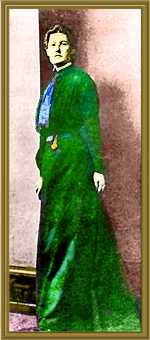 Jessie
Willcox Smith was born in Philadelphia in 1863. She originally
studied to be a kindergarten teacher and actually served in that
capacity before accidentally discovering a propensity for drawing.
She's one of the few illustrators I've profiled who wasn't an
astonishing child prodigy. She was probably around 20 before she
took up a pencil.
Jessie
Willcox Smith was born in Philadelphia in 1863. She originally
studied to be a kindergarten teacher and actually served in that
capacity before accidentally discovering a propensity for drawing.
She's one of the few illustrators I've profiled who wasn't an
astonishing child prodigy. She was probably around 20 before she
took up a pencil.
Initial studies were quickly replaced with formal courses at the Pennsylvania Academy of the Fine Arts where she learned from Thomas Eakins, and others. She graduated in 1888 and began a long, distinguished career. Her earliest work appeared in the monthly magazine for children, St. Nicholas.

 But
success as an illustrator wasn't immediate. She got a job in the
production department of The Ladies' Home Journal in 1889
and was still working there five years later when Howard Pyle began teaching illustration at
Drexel Institute of Arts and Sciences. Smith was
accepted as a pupil in his first class. At 31, she was only 10
years younger than her teacher and one of his oldest students.
She was soon joined in the class by Elizabeth
Shippen Green and Violet Oakley and the three became life-long
friends. Smith's first commission through Pyle was for an 1897
edition of Evangeline that she illustrated with Oakley.
The two joined with another Pyle student to rent a studio and
were later joined there by Green.
But
success as an illustrator wasn't immediate. She got a job in the
production department of The Ladies' Home Journal in 1889
and was still working there five years later when Howard Pyle began teaching illustration at
Drexel Institute of Arts and Sciences. Smith was
accepted as a pupil in his first class. At 31, she was only 10
years younger than her teacher and one of his oldest students.
She was soon joined in the class by Elizabeth
Shippen Green and Violet Oakley and the three became life-long
friends. Smith's first commission through Pyle was for an 1897
edition of Evangeline that she illustrated with Oakley.
The two joined with another Pyle student to rent a studio and
were later joined there by Green.
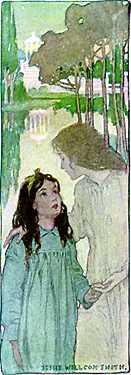 In
1901, the three shared the lease on an old inn outside of Philadelphia.
That's the same year as the illustration above from "The
Last of the Fairy Wands" in the December issue of Scribners
Magazine. She produced two calendars with Green for 1902 that
helped establish the careers of both women. The most important
was "The Child" which showcased some of her most sensitive
renditions of children to date. The images were collected into
a book the following year. One of Smith's three images from that
book is above at right. The magazines and books of the day were
voraciously consuming as much color work as could be found. Pyle's
students were some of the best-prepared new entrants into the
illustration market and Pyle's name got them all access to the
pages of the magazines.
In
1901, the three shared the lease on an old inn outside of Philadelphia.
That's the same year as the illustration above from "The
Last of the Fairy Wands" in the December issue of Scribners
Magazine. She produced two calendars with Green for 1902 that
helped establish the careers of both women. The most important
was "The Child" which showcased some of her most sensitive
renditions of children to date. The images were collected into
a book the following year. One of Smith's three images from that
book is above at right. The magazines and books of the day were
voraciously consuming as much color work as could be found. Pyle's
students were some of the best-prepared new entrants into the
illustration market and Pyle's name got them all access to the
pages of the magazines.
Pyle's influence may have given her a leg up, but it was Smith's talent that propelled her into the lofty ranks of the illustrators she had dealt with in The Ladies' Home Journal production department. By 1905, her clients now included Century, Collier's Weekly, Leslie's, Harper's, McClure's, Scribners, and that self-same Ladies' Home Journal. At left is one of the many illustrations she did for "In A Closed Room" by France Hodgson Burnett for McClure's in 1904 (later published in book form).
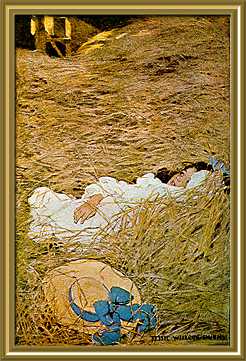 As
the book and magazine commissions continued, the focus of her
work began to gel. Children became more and more the subject,
whether it was exposé articles like "While the Mother Works:
A Look at the Day Nurseries of New York" (Century,
1902), books like the Scribners Classic edition of A Child's
Garden of Verses (in 1905 - see image at right), or just a
series of plates like "The Seven Ages of Childhood"
done for seven successive issues of The Ladies' Home Journal
in 1908-9. Though she never married nor had children of her
own, they became the center of her life and work.
As
the book and magazine commissions continued, the focus of her
work began to gel. Children became more and more the subject,
whether it was exposé articles like "While the Mother Works:
A Look at the Day Nurseries of New York" (Century,
1902), books like the Scribners Classic edition of A Child's
Garden of Verses (in 1905 - see image at right), or just a
series of plates like "The Seven Ages of Childhood"
done for seven successive issues of The Ladies' Home Journal
in 1908-9. Though she never married nor had children of her
own, they became the center of her life and work.
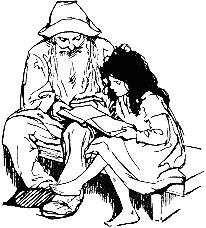 Some
of her best-loved books were A Child's Book of Stories
(1911), The Water-Babies (1916), At the Back of the
North Wind (1919), and Boys and Girls of Bookland (1923).
Others that carried through the child motif were: Dickens'
Children (1912), The Everyday Fairy Book (1915), A
Child's Book of Modern Stories (1920) and several others in
that "Child's Book" series. She also illustrated an
edition of Heidi. You can see from the drawing at left
that, like any good Pyle student, she was equally at home with
pen and the brush. But it is her paintings for which she is best
remembered. From the nearly Impressionistic straw of "The
Hayloft" to the sensuous Art Nouveau line of the North Wind's
hair, she brought a painterly eye to her images. The beauty and
joy and charm that she was able to convey while being totally
faithful to the precepts of Pyle is stunning. Revisiting her work
for this essay has given me a renewed appreciation for it. Of
all the other Pyle students, only Schoonover
managed to extend a career significantly past the 1920's. And
Smith's was much more visible.
Some
of her best-loved books were A Child's Book of Stories
(1911), The Water-Babies (1916), At the Back of the
North Wind (1919), and Boys and Girls of Bookland (1923).
Others that carried through the child motif were: Dickens'
Children (1912), The Everyday Fairy Book (1915), A
Child's Book of Modern Stories (1920) and several others in
that "Child's Book" series. She also illustrated an
edition of Heidi. You can see from the drawing at left
that, like any good Pyle student, she was equally at home with
pen and the brush. But it is her paintings for which she is best
remembered. From the nearly Impressionistic straw of "The
Hayloft" to the sensuous Art Nouveau line of the North Wind's
hair, she brought a painterly eye to her images. The beauty and
joy and charm that she was able to convey while being totally
faithful to the precepts of Pyle is stunning. Revisiting her work
for this essay has given me a renewed appreciation for it. Of
all the other Pyle students, only Schoonover
managed to extend a career significantly past the 1920's. And
Smith's was much more visible.
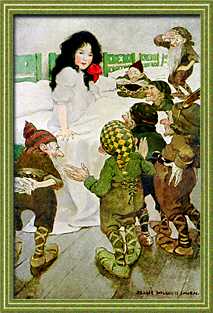
|
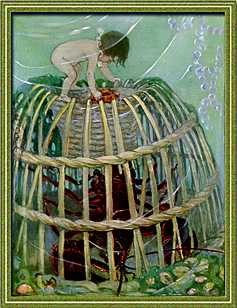
|
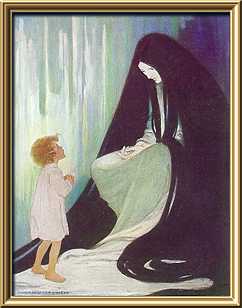
|
| A Child's Book of Stories | The Water-Babies | At the Back of the North Wind |
 It
was on the covers of Good Housekeeping that most people
became familiar with her art. For over 15 years she painted the
covers for one of America's most popular magazines. Month after
month, from December of 1917 through March of 1933, a new Jessie
Willcox Smith image was on the newsstands and in countless homes.
She painted the universal child, but the dresses and playsuits
they wore helped shape the dressing habits of a generation of
children.
It
was on the covers of Good Housekeeping that most people
became familiar with her art. For over 15 years she painted the
covers for one of America's most popular magazines. Month after
month, from December of 1917 through March of 1933, a new Jessie
Willcox Smith image was on the newsstands and in countless homes.
She painted the universal child, but the dresses and playsuits
they wore helped shape the dressing habits of a generation of
children.
She painted posters and portraits as well as illustrations
and advertisements. Her eyesight faded as she got older and it
was probably a major factor in her decision to stop painting the
Good Housekeeping covers. In that same year, 1933, Smith
made her first trip to Europe, but her infirmities made it more
trouble than fun. She died in her sleep in 1935. She was America's
premier female illustrator during most of her life.
 To learn more about Jessie Willcox Smith, see:
To learn more about Jessie Willcox Smith, see:| Jessie Willcox Smith | S. Michael Schnessel, T.Y. Crowell (c1977) |
| Great American Illustrators | Walt Reed, Abbeville 1979 |
| The Illustrator in America 1880-1980 | Walt and Roger Reed, Madison Square Press 1984 |
| Jessie Willcox Smith: A Bibliography | Edward D. Nudelman, Pelican 1989 |
| Jessie Willcox Smith: American Illustrator | Edward D. Nudelman, Pelican 1990 |
| The Vadeboncoeur Collection of Knowledge | Jim Vadeboncoeur, Jr. 1998 |
There's a good site with a more detailed biography and bibliography that's part of The Illustrators Project in The Elizabeth Nesbitt Room at The University of Pittsburgh. They're doing a great job there, so check them out, too. For art and information, visit Nudelman Fine Illustration.
|
Illustrations are copyright by their
respective owners. This page written, designed & © 1999 by Jim Vadeboncoeur, Jr. Updated 2011. |
